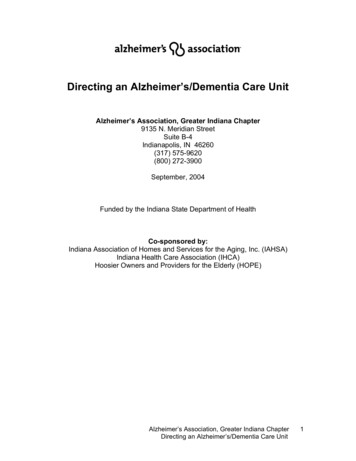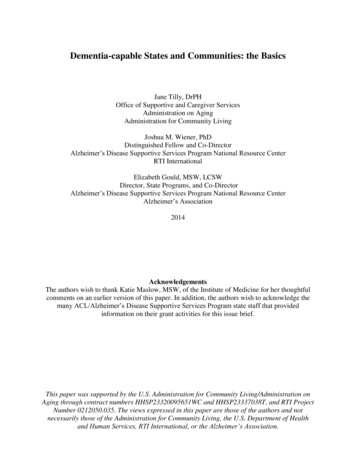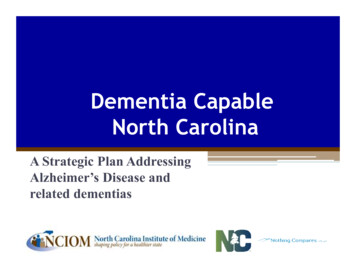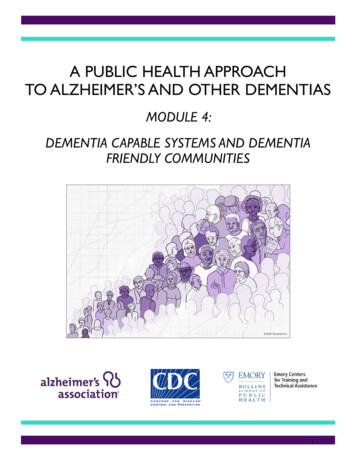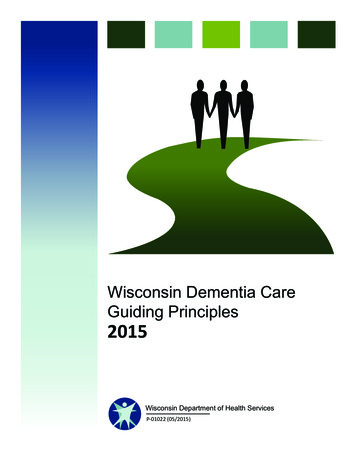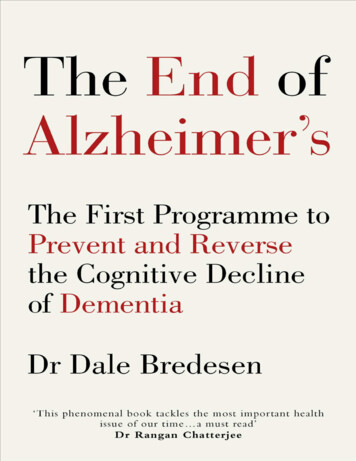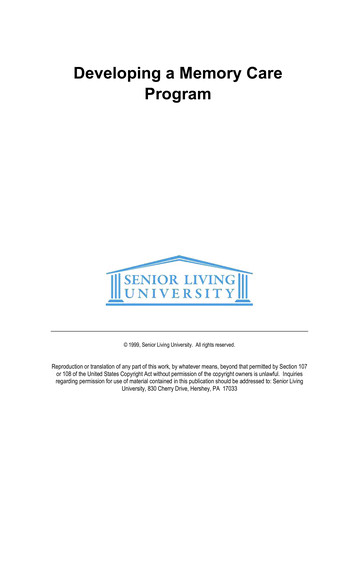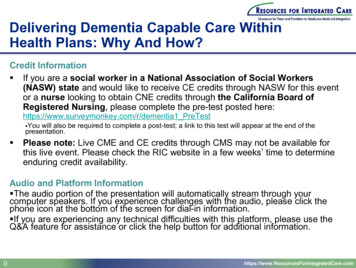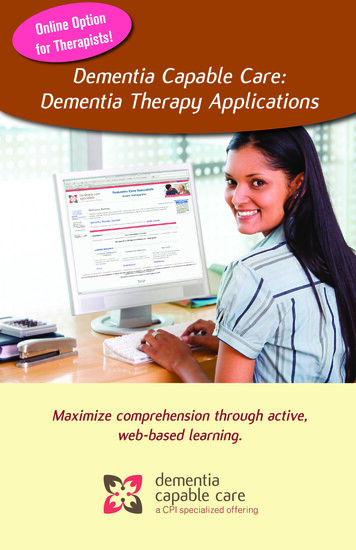
Transcription
UNDERSTANDINGALZHEIMER’SAND DEMENTIAGeri T., living with Alzheimer’s, andher husband and care partner, Jim
THE IMPACT OF ALZHEIMER’SAND DEMENTIACurrently, an estimated 50 million peopleworldwide are living with dementia,including more than 5 million Americans.Without changes in prevention ortreatment, this number could reach nearly14 million by 2050.The disease also affects the 16 millionAmericans who provide unpaid care forpeople living with Alzheimer’s or anotherdementia. More than 80% of care providedat home is delivered by family members,friends or other unpaid caregivers.The Alzheimer’s Association is availableacross the country and online to helppeople understand Alzheimer’s anddementia, and receive information andsupport they can trust.
CONTENTS1. Alzheimer’s and dementia. p.22. Alzheimer’s in the brain. p.43. Risk factors. p.54. Stages of Alzheimer’s disease. p.75. FDA-approved treatmentsfor symptoms. p.106. Advancing Alzheimer’s research. p.121
1.ALZHEIMER’SAND DEMENTIAThe terms “dementia” and “Alzheimer’s” are oftenused as though they mean the same thing. Theyare related, but there are important differencesbetween the two.DementiaDementia is a broad (“umbrella”) term for anindividual’s changes in memory, thinking orreasoning. There are many possible causes ofdementia, including Alzheimer’s.Alzheimer’sAlzheimer’s disease is the most common causeof dementia. It makes up 60% to 80% ofall dementia cases. Alzheimer’s is not a normalpart of aging — it’s a progressive brain disease,meaning it gets worse over time.Two abnormal brain structures called plaquesand tangles are the main features of Alzheimer’sdisease. Scientists believe they damage andkill nerve cells. Plaques are pieces of a proteinfragment called beta-amyloid that build up in thespaces between nerve cells. Tangles are twistedfibers of another protein called tau that build upinside cells.2
Other common dementias» Vascular dementia is a decline in thinkingskills that happens when blood flow tothe brain is blocked or reduced so thatbrain cells can’t get important oxygen andnutrients. Sometimes these changes occursuddenly, such as during a stroke that blocksmajor brain blood vessels. Vascular dementiais the second most common cause ofdementia after Alzheimer’s disease.» Dementia with Lewy bodies is a typeof progressive dementia related to buildupof a protein called alpha-synuclein thatdamages brain cells. Early symptoms includehallucinations and sleep problems.» Frontotemporal dementia (FTD) is a groupof disorders. Progressive cell degeneration(or breakdown) causes FTD in two places.One is in the brain’s frontal lobes (the areasbehind the forehead). The other is in thebrain’s temporal lobes (the regions behindthe ears).Visit alz.org/dementia to learn about other typesof dementia.John W., living with dementia with Lewybodies, and his wife and care partner, Gail3
2.ALZHEIMER’SIN THE BRAINMore than 100 years ago, Dr. Alois Alzheimerdescribed specific changes in the brain. Scientistsnow call them beta-amyloid plaques and tautangles. Today we know that Alzheimer’s is aprogressive brain disease. It is marked by thesekey changes and impacts memory, thinking andbehavior.What goes wrong in the brainThe brain has three main parts: the cerebrum,cerebellum and brain stem. Each has a job to doto make the body work properly.The cerebrum fills up most of the skull. It’s thepart of the brain most involved in remembering,problem-solving and thinking. There are about100 billion nerve cells called neurons throughoutthe brain that send messages in order to makememories, feelings and thoughts.TAKE A CLOSER LOOKVisit alz.org/brain to explore Inside the Brain:A Tour of How the Mind Works.4
Alzheimer’s disease causes nerve cells todie. This causes the brain to lose tissue (alsocalled shrinkage) and the loss of function andcommunication between cells. These changescan cause the symptoms of Alzheimer’s disease.These include memory loss; problems withthinking and planning; behavioral issues; and, inthe last stage, a further decline in functioning,which can even include trouble swallowing.3.RISKFACTORSScientists know that nerve cell failure is a partof Alzheimer’s disease, but they don’t yet knowwhy this happens. However, they have identifiedcertain risk factors that increase the likelihood ofdeveloping Alzheimer’s.AgeThe greatest known risk factor for Alzheimer’sis age. After age 65, a person’s risk of developingthe disease doubles every five years. Thirty-twopercent of people age 85 or older haveAlzheimer’s.Family historyResearchers have learned that people who havea parent, brother or sister with Alzheimer’s aremore likely to develop it than those who donot. The risk increases if more than one familymember has the disease.GeneticsTwo types of genes influence whether a persondevelops a disease: risk genes and deterministicgenes. Risk genes increase the chance ofdeveloping a disease but do not guarantee it willhappen. Deterministic genes cause a disease. Thismeans anyone who inherits a deterministic genewill develop a disorder.5
Rare deterministic genes cause Alzheimer’s ina few hundred extended families worldwide.Scientists estimate these genes cause less than1% of cases. Individuals with these genes usuallydevelop symptoms in their 40s or 50s.Hispanics, African Americans and womenResearch shows that older Hispanics are aboutone-and-a-half times as likely as older whitesto have Alzheimer’s and other dementias, whileolder African Americans are about twice aslikely. No one knows the exact reason for thesedifferences, but researchers believe they areconnected to higher rates of vascular disease inthese groups.Also, women live longer than men, making themmore likely to develop Alzheimer’s. However,living longer doesn’t completely explain thisdifference. Researchers are exploring howgenetic differences may impact disease risk.Lowering the risk of cognitive declineAge, family history and genetics are all riskfactors we can’t change. However, research isstarting to show clues about other risk factorsthat we may be able to influence. Studies show astrong connection between serious head injuryand future risk of Alzheimer’s. For this reason, it’simportant to protect your head by buckling yourseat belt, wearing a helmet when playing sportsand making sure your home is safe to avoid falls.Research also shows there are healthy lifestylehabits that people can adopt to help keep theirbrain healthy and lower their risk of cognitivedecline. These include eating a healthy diet,staying socially active, and exercising the bodyand the mind. Not using tobacco and avoidingexcess alcohol is also good for brain health.Science tells us there is a strong connectionbetween brain health and heart health. The risk6
of developing Alzheimer’s or vascular dementiaappears to be increased by many conditionsthat damage the heart and blood vessels. Theseinclude heart disease, diabetes, stroke, high bloodpressure and high cholesterol.The Alzheimer’s Association used this research todevelop 10 Ways to Love Your Brain, a collectionof tips that can help lower the risk of cognitivedecline. Learn more at alz.org/10ways.4.STAGES OFALZHEIMER’S DISEASEAlzheimer’s usually progresses slowly inthree general stages: early, middle and late. Ina medical setting, these stages are sometimescalled “mild,” “moderate” and “severe.”The symptoms of Alzheimer’s worsen overtime, but because the disease affects people indifferent ways, the rate of progression varies.On average, a person with Alzheimer’s may livefour to eight years after diagnosis, but somepeople live as long as 20 years.The following descriptions provide a general ideaof changes at each stage. Stages of Alzheimer’smay overlap, which can make it difficult to knowwhich stage a person is in.7
Early-stage Alzheimer’sIn the early stage, a person may functionindependently, but people who know theindividual well may begin to notice difficulties.These can include:» P roblems coming up with the right wordor name for something.» T rouble remembering names whenintroduced to new people.» D ifficulty with familiar tasks.» Forgetting something that was just read.» G etting lost in familiar places.» I ncreasing trouble with planningor organizing.Middle-stage Alzheimer’sMiddle-stage Alzheimer’s is usually the longeststage and can last for many years. As the diseaseprogresses, the person living with Alzheimer’s willneed more help. In the middle stage, symptomswill be noticeable to others and may include:» Forgetting events or one’s own personalhistory.» F eeling frustrated, angry or withdrawn,especially in socially or mentally challengingsituations.» C onfusion about where they are or the dayof the week.» Needing help to choose the right clothes forthe weather or occasion.» Trouble controlling bladder and bowels.» C hanges in sleep patterns. This may includesleeping during the day and restlessness atnight.» A higher risk of wandering and becominglost.8
» Personality and behavioral changes.The person may become suspicious ordelusional, believing that others are lying.Or, the person might repeat a behaviorover and over.Late-stage Alzheimer’sMajor personality changes can happen in thefinal stage of Alzheimer’s. The person will need alot of help with daily activities and personal care.In the late stage, individuals may:» Lose awareness of recent experiences aswell as of their surroundings.» Go through changes in physical abilities.This may affect their ability to walk, sit and,eventually, swallow.» Have more trouble communicating.» Be at higher risk of infections, especiallypneumonia.9
5.FDA-APPROVEDTREATMENTSFOR SYMPTOMSCurrently, there is no cure for Alzheimer’s,but non-drug treatments and medications mayhelp with memory, thinking and behavioralsymptoms for a while. It’s important to talkabout treatments with your doctor, startingwith non-drug options.Non-drug treatmentsNon-drug treatments for behavioral symptomscan offer physical and emotional comfort.Many of these strategies aim to identify andtake care of the needs of the person living withAlzheimer’s.Tips for coping with symptoms include:» Check for personal comfort. Look for pain,hunger, thirst, constipation, full bladder,fatigue, infections and skin irritation. Keepthe room temperature comfortable.» Don’t argue about facts. For example, if aperson would like to visit a parent who diedyears ago, don’t point out that the parent isno longer alive. Instead, say, “Your mother isa wonderful person. I would like to seeher, too.”» Redirect the person’s attention by gettingthem to think about something new. Try tobe flexible, patient and supportive. Respondto the emotion, not the behavior.» Create a calm environment. Avoid noise,bright lights and television, which causesdistraction.» Have rest times between lively events.» Give the person an object to hold thatmakes them feel safe.10
» Show the person that you hear them andanswer his or her questions.» Look for reasons behind each behavior.Talk to a doctor about behaviors that couldbe connected to medications or illness.» Try to find more than one solution.MedicationsThree types of drugs are currently approvedby the Food and Drug Administration (FDA) totreat cognitive symptoms of Alzheimer’s disease.The first type is cholinesterase (KOH-luh-NESter-ays) inhibitors. These drugs prevent thebreakdown of acetylcholine (a-SEA-til-KOHlean). Acetylcholine is a chemical messengerimportant for memory and learning. These drugssupport communication between nerve cells.The cholinesterase inhibitors most commonlyprescribed are:» Donepezil (Aricept )» Rivastigmine (Exelon )» Galantamine (Razadyne )The second type of drug works by regulating theactivity of glutamate. Glutamate is a differentchemical messenger that helps the brain processinformation. This drug is known as:» Memantine (Namenda )The third type of drug is a combination of acholinesterase inhibitor and a glutamate regulator:» Donepezil and memantine (Namzaric )11
These treatments produce different results indifferent people. They might help symptoms fora while, but they do not slow or stop the brainchanges that cause Alzheimer’s to become moresevere over time.6.ADVANCINGALZHEIMER’S RESEARCHResearch in the last 10 years shows thatAlzheimer’s starts many years before peopleliving with the disease notice symptoms. Withthis knowledge, researchers are working tofind people who are at risk before they havesymptoms and try to prevent the disease. Thiseffort may lead to a medication to stop or slowthe disease.To help advance important research tounderstand Alzheimer’s and find treatments,the Alzheimer’s Association funds researcherslooking at new treatment strategies andadvocates for more federal research funding.Clinical studies drive progressTaking part in a clinical study is one way thateveryone can help fight Alzheimer’s disease.Without volunteers for research, scientistscannot find ways to prevent, treat and, ultimately,cure the disease.Clinical trials test new drugs to be sure they aresafe and effective. Clinical studies test non-drugtreatments to learn how they affect things suchas quality of life. Every clinical trial or study givesus important knowledge, whether or not thestudy was successful.For people currently living with dementia, thereare other benefits to taking part in clinical trials,including access to expert medical care andpromising treatments.12
Visit alz.org/TrialMatch to learn more aboutAlzheimer’s Association TrialMatch , a free,easy-to-use clinical studies matching servicefor people living with dementia, caregivers andhealthy volunteers who don’t have dementia.TrialMatch has a database with hundredsof studies taking place across the countryand online. It’s your chance to learn aboutopportunities to participate in Alzheimer’sresearch.I don't have a laboratory.I have Alzheimer’s disease.And I’m helpingto discover a cure.You can, too.alz.org/TrialMatch800.272.3900Rebecca P., living with Alzheimer’s,TrialMatch user13
alz.orgAccess reliable information and resources, such as:» Alzheimer’s Navigator – Assess your needsand create customized action plans.» Community Resource Finder – Find resources,including your local Association chapter.» ALZConnected – Connect with othercaregivers or people with dementia.» Online Caregiver Resources – Get informationfor all stages of the disease.alz.org/educationFree online workshops, including:» Understanding Alzheimer’s and Dementia800.272.390024/7 Helpline – Available all day, every day.The Alzheimer’s Association is the leading voluntary healthorganization in Alzheimer’s care, support and research.Our mission is to eliminate Alzheimer’s disease throughthe advancement of research; to provide and enhancecare and support for all affected; and to reduce the riskof dementia through the promotion of brain health.Our vision is a world without Alzheimer’s disease .800.272.3900 alz.org This is an official publication of the Alzheimer’s Association but may be distributedfreely and without charge by unaffiliated organizations and individuals. Suchdistribution does not constitute an endorsement of these parties or their activitiesby the Alzheimer’s Association. 2019 Alzheimer’s Association . All rights reserved.Rev.Jul19770-10-0003
worldwide are living with dementia, including more than 5 million Americans. Without changes in prevention or . A Tour of How the Mind Works. 5 Alzheimer’s disease causes nerve cells to die. This causes the brain to lose tissue (also . Science tells us there is a strong c
